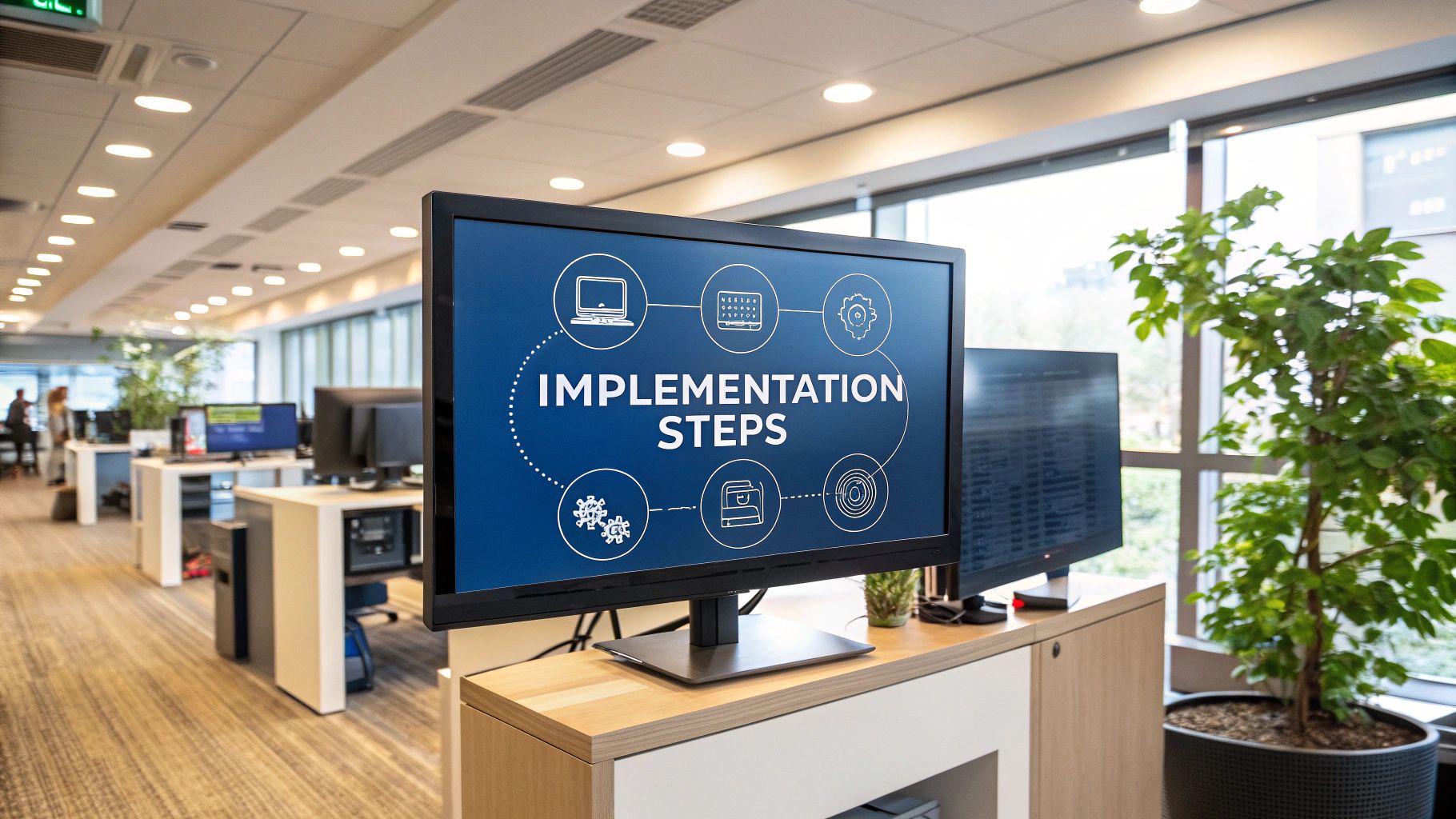Information Security Policy Examples: Essential Templates & Implementation Guide
Understanding Information Security Policy Fundamentals

Information security policies form the foundation of how organizations protect themselves against cyber threats. These policies establish clear rules and procedures for protecting sensitive data, define acceptable system usage, outline response protocols for security incidents, and create accountability around security responsibilities.
Why Are Information Security Policies Essential?
Well-designed security policies help organizations in several key ways. They reduce data breach risks by setting clear expectations and implementing security controls, helping avoid costly financial losses and damage to reputation. They also make operations more efficient by standardizing security practices and creating clear incident response procedures - when security issues arise, having defined policies helps minimize disruption.
Security policies also play a vital role in meeting regulatory requirements. Many sectors have specific data protection rules, like HIPAA for healthcare and GDPR for handling EU residents' data. Following these regulations through documented policies isn't optional - it's often required by law. Having solid policies demonstrates a serious commitment to protecting sensitive information.
Core Components of an Effective Policy
The best security policies start with a complete risk assessment. This means identifying potential threats, weak points, and what could happen if security fails. For instance, companies handling customer payment data need strong defenses against hacking and data theft. Based on these risks, policies should specify concrete security measures like access controls, password rules, and data encryption.
For policies to work, everyone needs to understand and follow them. Regular training helps ensure staff know the rules and their security duties. Government adoption of security policies has been slower than private industry - a 2020 survey found that 78.6% of responding government organizations had fully implemented formal cybersecurity policies, while 21.4% had partial policies in place. Read the full study here: Local Government Cybersecurity Policy Adoption. Security policies also need regular updates to address new threats and technology changes. This keeps protections current and effective for safeguarding critical information.
Key Standards and Frameworks in Security Policies
Organizations need clear security frameworks to build effective information security policies. The most widely adopted standards include ISO 27001, NIST, and industry-specific frameworks for sectors like healthcare and finance. These provide structured guidance that can be customized based on each organization's security needs.
Understanding Major Frameworks
ISO 27001 sets the global standard for information security management systems. It helps organizations protect the confidentiality, integrity, and availability of their data through proven best practices.
The NIST framework offers detailed guidelines spanning access control to disaster recovery planning. Many companies combine elements from multiple frameworks to meet their specific industry requirements and security goals.
Frameworks in Action: Practical Examples
The healthcare sector demonstrates why industry-specific standards matter. HIPAA requires strict security controls for protecting patient health information, with significant penalties for non-compliance including fines and legal consequences. Learn more about implementing security frameworks here.
Strategies for Selecting an Optimal Framework
When evaluating security frameworks, organizations should consider these key factors:
- Align with Business Goals: Choose frameworks that support your operational needs and risk management approach
- Conduct a Gap Analysis: Review current security practices against framework requirements to find gaps
- Engage Stakeholders: Get input and support from executives and departments for successful implementation
While implementing security frameworks takes effort, understanding these standards helps create strong, actionable policies. For more insights on data protection, read our guide here.
By carefully selecting and implementing security frameworks, organizations strengthen their security posture and meet compliance requirements. This creates a foundation for secure and resilient operations.

Step-by-Step Policy Implementation Guide

Creating effective information security policies requires more than just documentation - they must become part of your organization's daily practices. Success depends on careful planning, clear communication, and regular evaluation. Here's a practical guide to help implement these policies effectively.
Phase 1: Assessment and Planning
Start by understanding your current security posture and defining clear objectives. Conduct a thorough risk assessment to identify vulnerabilities in your information assets. Consider both internal factors (like data types and systems) and external requirements (such as industry regulations).
Different organizations have unique priorities - a healthcare provider faces different challenges than a bank. Set specific goals that address your key risks. What specific threats do you need to protect against? What are your main security objectives? Clear answers will guide your implementation. Learn more about creating effective policies: Information Security Policies.
Phase 2: Policy Development and Communication
With risks and objectives defined, develop specific policies using clear, straightforward language. Write procedures that employees can easily understand and follow. Make these policies readily available to everyone in the organization.
Good communication is essential for adoption. Plan training sessions, create reference materials, and send regular reminders about security procedures. Set up feedback channels where employees can ask questions and suggest improvements. This helps identify unclear policies that need adjustment.
Phase 3: Implementation and Enforcement
Put your policies into practice through a structured rollout. This may require updating systems, adding security tools, or changing work processes. Assign a dedicated team to manage the implementation and address any issues that arise.
Consistent enforcement keeps policies effective. Use regular audits and monitoring to ensure compliance. Have clear consequences for security violations. Build a culture where everyone understands their role in protecting company information.
Phase 4: Monitoring and Review
Security needs constant attention as threats change. Schedule regular policy reviews to evaluate effectiveness. Gather employee feedback and stay current on security best practices. Update policies when needed to address new risks.
Regular assessment shows stakeholders your commitment to security. This ongoing improvement process helps keep your policies relevant and your organization protected. Following these phases helps create lasting security practices that protect your organization's information assets.
Sample Templates and Policy Examples That Work

Basic security policy templates rarely meet an organization's specific security needs. To be effective, policies must reflect your company's unique risks and operations. Let's explore real examples and practical approaches for creating policies that actually improve security.
Practical Examples of Effective Policies
The most successful security policies start with a clear mission statement. This explains what the policy aims to achieve - like protecting customer data and maintaining business trust. Such focused objectives guide the specific rules and procedures that follow.
Clear assignment of roles is essential. Everyone needs to know exactly who handles policy implementation and incident reporting. Real-world examples help staff understand how the rules apply in practice. For instance, showing proper handling of customer data in day-to-day scenarios makes policies more concrete and actionable.
Adapting Templates to Your Organization
While templates provide a starting point, you must customize them for your specific needs. Industry regulations play a key role - healthcare companies must follow HIPAA rules, while financial firms need to meet GLBA requirements. This ensures both relevance and compliance.
Your company's size and structure should shape the policy details. A 10-person business has different security needs than a 1,000-person enterprise. Consider your IT systems too - more complex infrastructure requires more detailed policies. This targeted approach makes policies practical to implement.
Building a Template From Scratch
When creating a policy from scratch, focus on clear writing that all staff can understand. Skip technical jargon and use straightforward language. Break content into logical sections with clear headers and bullet points for easy reference.
Key policy components should include:
- Acceptable system use guidelines
- Data classification rules
- Access control procedures
- Security incident response steps
Set up regular policy reviews - at least annually. Security threats constantly change, so policies need updates to stay effective. Reviews also help identify outdated sections and align with current best practices. Make policy maintenance an ongoing priority, not a one-time task.
Building Effective Policy Communication Programs
Creating strong information security policies is just the start. The real work lies in making these policies understandable and actionable for employees at all levels. This means converting technical requirements into clear guidance that makes sense to everyone, from executives to frontline staff.
Designing Engaging Security Awareness Training
The best training programs do more than check compliance boxes - they build a mindset where everyone understands their role in protecting company data. Leading companies achieve this through interactive learning experiences rather than dry presentations and quizzes. This includes hands-on simulations, practical exercises, and even game-like challenges that make security training memorable.
For example, instead of just listing password rules, a program might walk employees through a mock phishing attack to show what can happen with weak passwords. This hands-on practice is much more effective than reading policy documents. Training should also match each team's needs - salespeople need different security guidance than IT staff.
Maintaining Continuous Security Awareness
Security awareness requires ongoing reinforcement since threats keep changing. Regular activities like quick tips, knowledge checks, and phishing simulations help keep security practices fresh in employees' minds. This steady engagement reminds everyone why following policies matters. For more guidance, see How to master your data breach response plan.
Measuring Training Effectiveness and Adapting to Change
Success goes beyond tracking completion rates. The real measure is whether behaviors improve. Key questions include: Are employees following security procedures? Have phishing test results gotten better? These metrics show if training truly makes a difference.
Your training approach should grow along with emerging threats. Gather employee feedback regularly and learn from any security incidents. This keeps your policy communication relevant and effective at protecting company information. Using real data to refine your methods helps build a more secure organization.
Measuring and Maintaining Policy Success
An information security policy is only valuable if it delivers real-world protection against threats. Success requires looking beyond basic compliance checklists to focus on meaningful results through careful monitoring, employee input, and regular policy updates.
Establishing Meaningful Metrics
The true test of policy effectiveness lies in preventing and managing security incidents. Key performance indicators should track:
- Number of successful phishing attacks
- Average incident detection and response time
- Total cost impact of security breaches
Tracking these metrics helps identify areas needing improvement. For example, fewer successful phishing attacks indicates better employee security awareness, while faster incident response times show improved threat management capabilities.
Gathering Feedback and Fostering Continuous Improvement
Regular employee feedback is essential for refining policies. Ask staff about:
- Policy clarity and understandability
- Practical implementation challenges
- Suggestions for improvement
This feedback loop helps spot gaps and opportunities for simplification. For instance, if many employees struggle with certain password requirements, those rules may need adjustment. Learn more about document management best practices in our guide: How to master document management best practices.
Building Sustainable Review and Update Processes
Annual policy reviews are crucial given how quickly security threats evolve. Create a structured review process that:
- Involves stakeholders across departments
- Documents all policy changes
- Communicates updates clearly to staff
- Provides refresher training when needed
Just as software needs security patches, policies require regular updates to address emerging threats. A sustainable review cycle, combined with active measurement and employee input, builds strong information security that protects your organization's critical assets.
Learn more about Whisperit and how our AI-powered dictation and text editing platform can help streamline your document workflows while maintaining security.